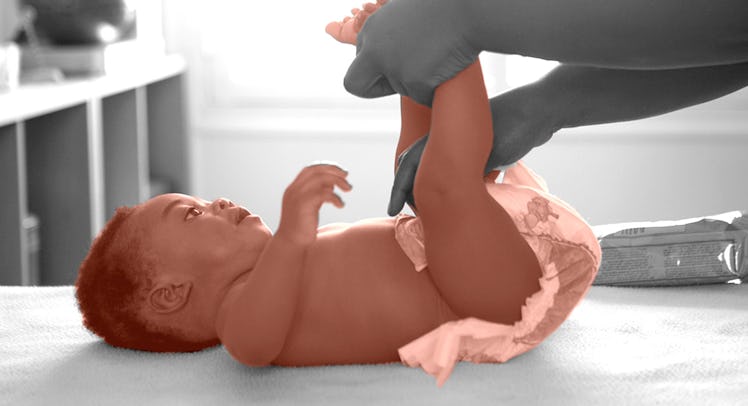How to Fight Diaper Rash and Win
Controlling the inevitable diaper rash requires keeping kids dry, keeping them clean, and keeping them healthy.

When a diaper does its job, it contains all the shit and piss that might otherwise ruin onesies, cribs, couches, or a family meal. That’s convenient for keeping a clean house, but having all that moisture and waste trapped next to the baby’s skin isn’t very good for them. Skin integrity starts to suffer if that diaper doesn’t get changed quickly. Early signs of diaper rash are redness or small raised bumps on the buttocks, genitals, and lower abdomen. Once the skin has started to become irritated, each dirty or wet diaper that follows can compound the problem. Considering all the sensitive parts located there, it can turn a happy-go-lucky kid pretty fussy pretty quickly.
READ MORE: The Fatherly Guide to Poop, Diapers, and Potty Training
It can also occur at any time a kid is in diapers — though it’s more likely in newborns (who produce a prodigious amount of feces for their size), babies who are starting solids around nine or ten months of age, and kids suffering from diarrhea due to illness or antibiotics. When it does happen, there is only one way to fight back: Minimizing the time urine and stool are in contact with the skin. Doing so effectively can clear up diaper rash in three or four days. This is so important and effective someone even invented an electric diaper to notify parents. The thing to remember is that, as Dina DiMaggio, M.D., a pediatrician at Pediatric Associates of NYC and at the NYU Medical Center, Fellow of the American Academy of Pediatrics, and co-author of The Pediatrician’s Guide to Feeding Babies and Toddlers, points out, “There would be no diaper rash without a diaper.”
Parents fighting diaper rash are really pushing back on the side effects of disposable undergarments by a variety of means. First? Being quick and diligent with changes. Second? Wiping. Well, they’re called wipes, but when a baby has a diaper rash, dabbing is a much better option than wiping. Wiping creates too much friction and can irritate already-sensitive skin. Parents should try to avoid using wipes with heavy fragrance or detergent – those agents can make skin irritation worse. Some parents may opt out of wipes altogether. A clean rag dipped in water and dabbed on the soiled areas, or even a spray bottle filled with water, are options for cleaning without a disposable wipe. Parents just need to make sure the area is patted dry before putting the diaper on.
A petroleum or zinc oxide-based ointment can help keep moisture away from the skin, though it’s not a substitute for diligent diaper changing. Some products may work better than others; some may be stickier than others, or harder to wash off of hands or out of clothes. The number one priority should be how well it protects skin. From what? Infection.
“If it doesn’t go away, it could be a yeast infection. That needs an anti-fungal cream,” explains DiMaggio. Yeast infections look like a red, spotted rash. “If it looks infected – it looks yellow or crusty, or has little blisters – then it might need an anti-bacterial cream.”
Coxsackievirus (also known as Foot and Mouth Disease) can also manifest as a rash, as can any number of allergic reactions to dyes and fragrances. So the persistent presence of what seems like diaper rash might warrant a bit more ointment but, weeks later, might best be shown to a doctor.
While not quite so helpful as an ointment, air is very good. Since infants should do tummy time anyway, putting down a towel or pad and having naked tummy time can give that irritated skin a chance to breathe. If there’s no reason to have a kid in a diaper, get the diaper off the kid. The results can be a bit gross, but it’ll help prevent longer-term dermatological issues.
To repeat, the steps are as follows: Keep the kid clean and dry; use wipes carefully; give the kid a little commando time; keep an eye out for persistent skin problems. There’s also this: Diaper rash happens. There’s no need for recrimination or extreme concern. Just solve the problem so the kids feel safe and comfortable.
This article was originally published on